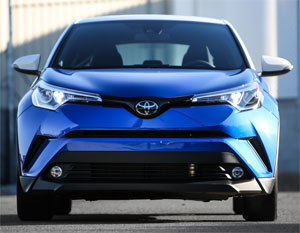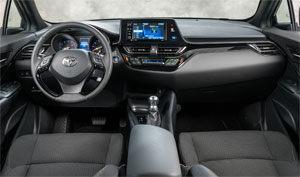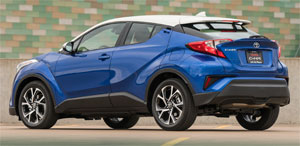2018 Toyota C-HR
The upside of the Scion brand’s demise is that things are getting a little more exciting at corporate parent Toyota. This re-branded C-HR, or coupe high rider, gives Toyota a much-needed entry into the subcompact utility category, and one with looks that are quite out there. But, does C-HR also deliver meaningful utility, or is it all about funky style?
First things first, the 2018 Toyota C-HR does indeed give Toyota another entry into what is the fastest growing vehicle choice today, utility vehicles. It slides under the Rav4 in their car-based crossover lineup. First revealed in concept form at the 2014 Paris Motor Show, the CH-R also indicates a bolder direction in overall Toyota design.
The production model clearly resembles that concept, but is far from an exact copy. The front end sets a very confident tone; while deep-cut body lines point towards the C-pillars, where there’s both a floating roof design and high-mounted door handles.
From there, an almost horizontal back glass leads to a hacked-off rear with its own aggressive lines. Wheelbase is less than an inch shorter than the RAV4, yet there’s over a foot difference in overall length. 18-inch alloys and 50-Series tires are standard.
 There are plenty of aero treatments that the kid’s love these days, including diffuser, spoiler, wheel spats, and even “vortex generators”.
There are plenty of aero treatments that the kid’s love these days, including diffuser, spoiler, wheel spats, and even “vortex generators”.
Those high-mounted door handles actually work great. But, do yourself a favor and skip the white roof option; unless you’re going for the taxicab look.
No all-wheel-drive for now, front-wheel-drive only. No factory turbo either, as those front wheels get power from a naturally aspirated 2.0-liter I4 good for 144–horsepower and 139 lb-ft. of torque. Toyota is leaving it to the aftermarket to add more.
Unfortunately, it’s CVT only for tranny duties.
But not so fast; that CVT does a good job of delivering the moderate power smoothly, and CVT-induced engine noise is relatively minor here, as is noise in general.
It’s also has a very solid feeling for a small ute, riding on the Toyota Prius’ recently updated New Global Architecture chassis. Handling is quite good, as it remains very flat in corners, urging you to push it harder than you probably should; though there’s not enough power here for you to really get yourself into too much trouble.
Through the rolling Hill Country around Austin, Texas, we found steering to be very quick, with good feedback through the wheel, as well as through the brake pedal.
 Things are very sporty in both look and feel inside, with a hip Scion-like touchscreen audio display, but no Satellite radio, Apple CarPlay, or Android Auto.
Things are very sporty in both look and feel inside, with a hip Scion-like touchscreen audio display, but no Satellite radio, Apple CarPlay, or Android Auto.
Likewise, gauges are more Scion than Toyota; with a 4.2-inch TFT multi-instrument display that gives lots of info including a G-Force monitor.
Front seat space is plentiful and are sufficiently comfortable. All controls are within easy reach. Rear seats are claustrophobic. Not a lot of space, and very little window to see out of; though there are belts for 3 back here.
Like many sub-compact crossovers, cargo space is just adequate; 19.0 cubic-ft. puts it slightly under the Honda HR-V, but much higher than the Mazda CX-3. Folding the seatbacks takes it to more acceptable 36.4 cubic-ft.
Now, as for what this Coupe High Rider crossover is not; well, despite its slick shape, it’s not a coupe, more of a 5-door hatchback. And it doesn’t ride overly high either, with just 5.9-inches of ground clearance. And it’s certainly not a traditional crossover without all-wheel-drive. So what’s left? A lot of target marketing and a respectable amount of fun.
 No skimping on safety features however. Toyota’s unfortunately-named Safety Sense P, with Pre-Collision System and Full-Speed Range Dynamic Radar Cruise Control, is standard, as are 10-airbags.
No skimping on safety features however. Toyota’s unfortunately-named Safety Sense P, with Pre-Collision System and Full-Speed Range Dynamic Radar Cruise Control, is standard, as are 10-airbags.
Government Fuel Economy Ratings are 27-City, 31-Highway, and 29-Combined. For a better than average Energy Impact Score of 11.4-barrels of yearly oil use with 5.0-tons of CO2 emitted.
As for the sticker prices? Base XLE trim starts at $23,460; XLE Premium, at $25,310. That puts it above the Mazda3, Honda HR-V, and Nissan Juke; however, both models are very well equipped, and without options to hike that price up further.
In today’s “multi-culti” world, where we try to combine the best attributes of all cultures; the 2018 Toyota C-HR tries to put crossover practicality into a conglomeration with youthful style and peppy performance; and for the most part succeeds very well.
But still, it’s a form over function piece that much like the Nissan Juke, will appeal mostly to city-dwelling urban adventurers who need an easy to park ride with more flexibility than the typical compact. But, even without all-wheel-drive, that may be enough to give the Scion faithful an easy entry into the “Mother Brand” and make this high ridin’ coupe a hit for Toyota.
Specifications
- Engine: 2.0 liter
- Horsepower: 144
- Torque: 139 lb-ft.
- EPA: 27 mpg city / 31 mpg highway
- Energy Impact: 11.4 barrels of oil/yr
- CO2 Emissions: 5.0 tons/yr
2025 Volkswagen ID. Buzz
Volkswagen Brings Beetlemania Level Of Excitement To Minivan Segment
The duty of upholding Volkswagen’s heritage has most recently been delegated to small legacy car names like Golf and Jetta. But hold on! A much larger, totally modern take on VW’s classic microbus has just buzzed over the horizon— the all-electric ID. Buzz. It’s been at the top of our minds since we first saw the concept back in 2017. Well, it’s finally here, so let’s get our groove into drive!
This 2025 Volkswagen ID. Buzz has indeed created the most buzz around Volkswagen since the Beetle’s return to the U.S. in the late 1990s. We couldn’t drive it anywhere without drawing a crowd. No wonder, just about everyone has a VW Microbus story to tell, and seeing this reimagined version rolling down the street brings back all those memories.
VW really pulled it off as far as we’re concerned, as it looks great without appearing over the top. All the cues are here: Big VW logo front and center, lots of greenhouse including A-pillar windows and mini sliders for the second-row passengers, D-pillar air vents, and two-tone wheels. And while its appearance may be pure retro, its drivetrain is far from it, as the ID. Buzz is all-electric, and unlike the new Beetle, the Buzz does retain the original Microbus’ rear-drive architecture.
Powering those rear wheels is a 210-kW motor drawing juice from a 91-kWh battery for a range of 234 miles; 200-kW max charging will get you to 80% in about 26 minutes. Buyers can add another small 80-kW motor up front for 4motion all-wheel-drive and an increase of total output from 282 to 335 horsepower with a combined 512 lb-ft of torque. It uses the same battery, but range estimates drop just slightly to 231 miles. But while those numbers are modest, we also found them to be quite conservative, as we observed as many as 287 miles available in our all-wheel-drive tester’s gauge display and were on pace for 273 miles in our driving loop.
One throwback theme that may be a turnoff to some is that it’s quite a step up into the Buzz’s front seats, but there’s certainly a commanding view of the road once you climb in. Second row seating can be either a three-place bench or a pair of captain’s chairs, so there’s generous room for seven or six passengers. The captain’s chairs in our Pro S Plus offer good support and very easy access to the third row.
Lots of flexibility too with the option to simply fold the seats or remove them altogether.
With the sliding side doors and a wide opening rear hatch, there’s plenty of access for loading big sport utility amounts of cargo. Lots of flexibility too with the option to simply fold the seats or remove them altogether, and the ability to create a full-length flat floor with a rear cargo shelf that covers some handy removable storage bins. There’s 18.6 cubic-feet of space behind the third row, 75.5 behind the second, and a max of 145.5. That’s more than a Chevrolet Tahoe. For smaller items, there are lots of cubbies throughout the cabin, along with a standard Buzz Box that can be moved to multiple locations.
With a design that prioritizes retro form and modern function over aero efficiency, the 4motion equipped ID. Buzz earns a Fair efficiency rating, using 42-kWh of electricity per 100 miles, and we weren’t sure what to expect at our Mason Dixon test track.
What we found was great torque off the line and drama free launches to 60 in just 5.3 seconds. It was very stable at speed and power delivery stayed steady most of the way down the track until we reached about 90 mph, when it began to taper off just before we finished the quarter-mile in 14.0 seconds flat at 97 mph.
With 1,200-lbs. of battery weight nestled in its 127.5-inch wheelbase, the Buzz felt planted to the pavement through our handling course. There was quite a bit of body roll to deal with, but surprisingly little understeer. In panic braking runs, pedal response was inconsistent, feeling soft at times, pushing back hard at others; but through it all, results were quite good, stopping from 60 in an average of just 108 feet.
Three interior themes are available, this Dune is the brightest, featuring coastal inspired wood optic dash décor, “gray and clay” leatherette surfaces, and a high-mounted central 12.9-inch touchscreen. Pricing starts with a rear-wheel-drive Pro S at $61,545; this Pro S Plus begins at $65,045, add another $4,500 for 4motion, which brings a few extra features along with all-wheel drive.
Retro design with old-school VW charm, modern EV drivetrain, big SUV capacity merged with minivan flexibility; it all comes together in this 2025 Volkswagen ID. Buzz. It’s easily one of the coolest rides of the year and one that will likely keep Volkswagen dealers buzzing for years to come, and that’s something no other people and things mover can say.
Specifications
As Tested
- Motor Setup: Dual-Motor AWD
- Battery Size: 91-kWh
- Horsepower: 335
- Torque: 512 lb-ft
- EPA Range: 231 miles
- 0-60 mph: 5.3 seconds
- 1/4 Mile: 14.0 seconds at 97 mph
- Braking, 60-0: 108 feet
- MW Test Loop: ~ 273 miles













































